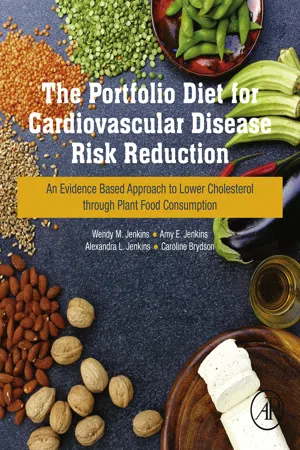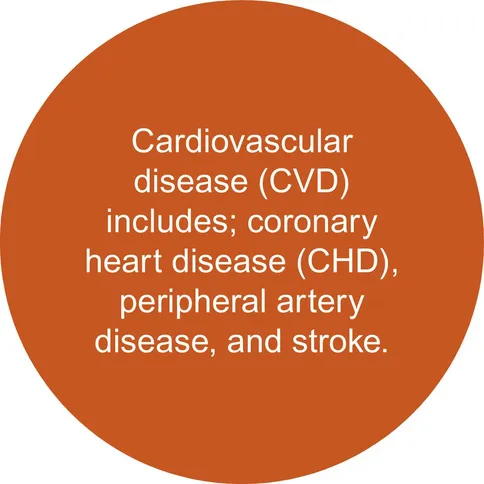
The Portfolio Diet for Cardiovascular Disease Risk Reduction
An Evidence Based Approach to Lower Cholesterol through Plant Food Consumption
- 236 pages
- English
- ePUB (mobile friendly)
- Available on iOS & Android
The Portfolio Diet for Cardiovascular Disease Risk Reduction
An Evidence Based Approach to Lower Cholesterol through Plant Food Consumption
About this book
The Portfolio Diet for Cardiovascular Disease Risk Reduction: An Evidence Based Approach to Lower Cholesterol through Plant Food Consumption examines the science of this recommended dietary approach to reduce cholesterol in addition to other risk factors for cardiovascular disease. With a thorough examination into the scientific rationale for the use of this diet, discussions are included on the experimental findings both for the diet as a whole, and its four principle food components: nuts and seeds, plant based protein, viscous fibers, and plant-sterol-enriched foods. Environmental and ethical considerations of the diet are also discussed, showing the ramifications of food choice on health and beyond. Referenced with data from the latest relevant publications and enhanced with practical details (including tips, dishes, and menus), the reader is enabled to meet the goals of cholesterol lowering and cardiovascular disease risk reduction while also taking the health of the planet into consideration.- Provides the scientific basis for the selection of the foods included in the Dietary Portfolio and the experimental evidence demonstrating cholesterol lowering and cardiovascular risk factor reduction- Provides an understanding of the current guidelines for lowering cholesterol and other risk factors of cardiovascular disease, explaining how the Dietary Portfolio effects these components and compares to other diet based approaches- Provides a holistic view of the Dietary Portfolio by investigating issues of sustainability and ethics in the food system- Allows readers to acquire the skills to successfully construct a potent cholesterol-lowering diet- Includes tips, recipes and meal planning aids
Frequently asked questions
- Essential is ideal for learners and professionals who enjoy exploring a wide range of subjects. Access the Essential Library with 800,000+ trusted titles and best-sellers across business, personal growth, and the humanities. Includes unlimited reading time and Standard Read Aloud voice.
- Complete: Perfect for advanced learners and researchers needing full, unrestricted access. Unlock 1.4M+ books across hundreds of subjects, including academic and specialized titles. The Complete Plan also includes advanced features like Premium Read Aloud and Research Assistant.
Please note we cannot support devices running on iOS 13 and Android 7 or earlier. Learn more about using the app.
Information
The Power of Diet in CVD Risk Factor Reduction
Abstract
Keywords
Introduction

| Diet | CVD-Related Target | Key Components of Dietary Pattern |
|---|---|---|
| Low Carb diet | WL | Atkins [1] – Carbohydrate < 20% of total energy intake, high in animal products, high in fat. Eco-Atkins [2]– Increased protein and fat from gluten and soy products, nuts, and vegetable oils. |
| DASH[3] | BP | – High in low fat fermented dairy products, vegetables, whole grains, poultry, fish, and nuts. – Low consumption of red meat recommended. Omni heart variations [4]:– 10% of carbohydrate derived energy replaced with mostly plant-based sources of protein. – 10% of carbohydrate derived energy replaced with unsaturated fats (mainly monounsaturated). |
| Low Glycemic Index Diet[5] | BL, WL | – No specified portion sizes or optimal calories specified. Relies on consumer constructed plan based on GI/GL values of foods. – Typically high in plant-based foods and whole grains. – The Zone, Sugar Buster and the Slow Carb Diet are all based off this diet and contain more specific parameters. |
| Mediterranean [6,7] | Overall CVD | – High in fresh fruits, vegetables, whole grains, fatty fish, nuts, plant-based oils, and margarine. – Low in red meat. |
| Nordic[8] | Overall CVD | – Including oily fish (salmon and mackerel), vegetables, roots, legumes, fruits, berries, and wholegrain cereals (oat, rye, and barley). |
| Okinawan[9] | BP | – Traditional diet rich in fish, seaweed, soybean products, vegetables, and green tea. |
| Ornish[10] | Overall CVD | – Vegetarian, high fiber and low fat diet. |
| Portfolio Diet[11] | BL | – High in whole grains, legumes, plant sterols (plant based oils), nuts, viscous fiber foods (barley, okra, psyllium), berries and soy. |
| Pritikin[12] | Overall CVD | – Low fat, emphasis on complex carbohydrates: less than 10% of calories from fat, 10%–15% from protein and 75%–80% complex carbohydrates. – Added exercise component. |
| Vegetarian[13] | BP, BL | – High in fruits and vegetables, legumes, nuts, whole grains, moderate amounts of dairy and eggs. |
| Zone[14] | GH | – Based on macronutrient distribution, with heavy emphasis on protein. Each daily meal consists of: 30% protein, 40% carbohydrates, 30% fats. |
- ● Low-carbohydrate diets like Atkins may negatively affect CVD risk in the long run once the benefits of weight-loss have plateaued as low-density lipoprotein cholesterol (LDL-C) levels remain high.
- ● Eco-Atkins, a high protein, plant-based variation of the Atkins diet, resulted in reductions in both waistlines and LDL-C.
- ● Both a low GI diet and the Portfolio diet have been observed to reduce body weight over the long term.
- ● Significant reductions in blood pressure (BP) were observed for the DASH diet, the Vegetarian diet, the Portfolio diet, and the Mediterranean diet, likely due to the high consumption of fruits and vegetables common to these diets.
- ● LDL-C reductions are seen in the Portfolio, Nordic, Mediterranean, DASH, and Low GI diet.
- ● There is strong evidence for the benefits of reducing LDL-C irrespective of baseline LDL-C levels.
- ● LDL-C: HDL-C (low-density lipoprotein: ...
Table of contents
- Cover image
- Title page
- Table of Contents
- Copyright
- Dedication
- Foreword
- Acknowledgments
- Introduction
- Chapter 1: The Power of Diet in CVD Risk Factor Reduction
- Chapter 2: Development and Evidence Base
- Chapter 3: How It Works: Mechanisms of Action
- Chapter 4: The Pantry: Tips and Tricks
- Chapter 5: Recipes
- Chapter 6: Why a Plant-Based Diet?
- Glossary
- Index
